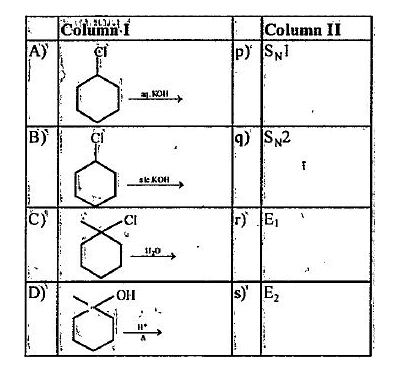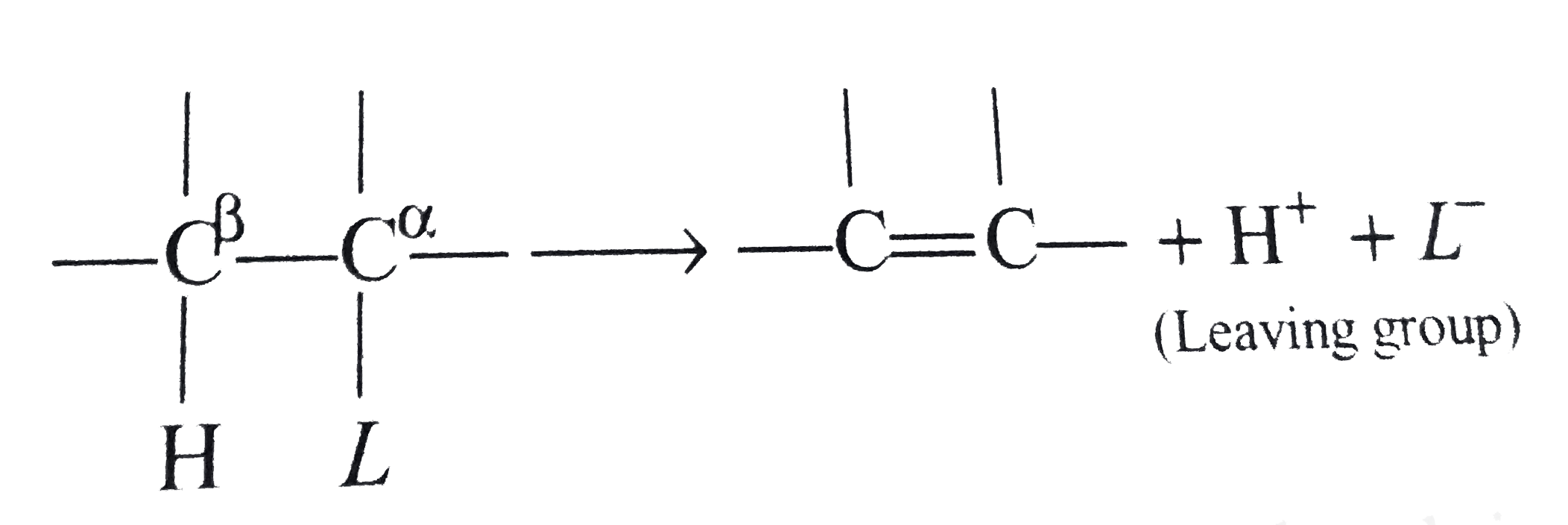Assertion : E1cB reaction is favoured by stabilisation of carbanion and poor leaving group.
Reason : The reaction is kinetically of the second order and unimolecular. Solution in Malayalam
Statement 1 is True, statement 2 is True, Statement 2 is Correct explanation for Statement 1.
Statement 1 is True, Statement 2 is True, Statement 2 is NOT a correct explanation for Statement 1.
Statement 1 is True, Statement 2 is False.
Statement 1 is False, Statement 2 is True.
The correct Answer is:B
Statement 1 is True, Statement 2 is True, Statement 2 is NOT a correct explanation for Statement 1.
Topper's Solved these Questions
- BOOK - BRILLIANT PUBLICATIONCHAPTER - ISOMERISM AND REACTION MECHANISMEXERCISE - LEVEL - III (Linked Comprehension Type) (Paragraph I)3videos
ISOMERISM AND REACTION MECHANISM
- BOOK - BRILLIANT PUBLICATIONCHAPTER - ISOMERISM AND REACTION MECHANISMEXERCISE - LEVEL - III (Linked Comprehension Type) (Paragraph II)3videos
ISOMERISM AND REACTION MECHANISM
- BOOK - BRILLIANT PUBLICATIONCHAPTER - ISOMERISM AND REACTION MECHANISMEXERCISE - LEVEL - III (Matching Column Type)6videos
ISOMERISM AND REACTION MECHANISM
- BOOK - BRILLIANT PUBLICATIONCHAPTER - HYDROGENEXERCISE - LEVEL -III ( Linked Comprehension Type)8videos
HYDROGEN
- BOOK - BRILLIANT PUBLICATIONCHAPTER - ORGANIC CHEMISTRY : SOME BASIC PRINCIPLES - PART I (NOMENCLATURE) EXERCISE - LEVEL-III45videos
ORGANIC CHEMISTRY : SOME BASIC PRINCIPLES - PART I (NOMENCLATURE)
Similar Questions
The leaving group is that functional group which is ejected with electrons of the o-bond in a reaction. Better the leaving group, faster is the reaction. The relative leaving abilitiy of the leaving group X in (R-X) is increased by:
i. The polarisability of (R-X) bond ii. The degree of stabilisation through solvation of X.
iii. The strength of (R-X) bond. iv. The stability of XΘ.
The leaving group tendency is also called fugacity.
Which statement is wrong?02:21View SolutionStability of carbocations depends upon the electron releasing inductive effect of groups adjacent to positively charged carbon atom involvement of neighbouring groups in hyperconjugation and resonance.
From the following resonance structures of CH3−⋅⋅O⋅⋅−+CH2 predict which of the structures is more stable? : CH−3O−+CH2 , CH3−+O⋅⋅=CH2, CH2=−O⋅⋅−CH3 , All are equally stable02:00View SolutionMatch the following Column I and Column II :
 03:33View Solution
03:33View SolutionThe volume of 10 volume H2O2, solution that decolourises 200 ml of 2NKMnO4, solution in acidic medium is:
03:48View SolutionGive the IUPAC name of the following compound:
 03:18View Solution
03:18View SolutionAssertion (A) : The rate constant of a pseudo unimolecular reaction has the units of a second order reaction. Reason (R ): A pseudo unimolecular reaction is a reaction of second order in whiich one of the reactant is present in large excess.
05:47View SolutionElcB reaction is favoured by stabilisation of carbanion and poor leaving group.
The reaction is kinetically of the second order and unimolecular.05:07View SolutionThe removal of two atoms or groups one generally hydrogen (H+) and the other a leaving group (L−) resulting in the formation of unsaturated compound is known as elimination reaction.

In E1 (elimination) reactions the C-L bond is broken heterolytically (in step 1) to form a carbocation ( as in SN1 reaction) in which (L−) is lost (rate determining step). The carbocation (in step 2) loses a proton from the β− carbon atom by a base (nucleophile) to form an alkene. E1 reaction is favoured in compounds in which the leaving group is at secondar (2∘) or tertiary(3∘) Position.
In E2 (elimination) reactions two sigma bonds are broken and a π−bond is formed simultaneously.E2 reactions occur in one step through a transition state.

E2 reactions are most common in haloalkanes (particulary 1∘) and better the leaving group higher is the E2 reaction. In E2 reactions, both the leaving groups should be antiplaner.
E1cb (Elimination unimolecular conjugate base) reaction involves the removal of proton by a conjugate base (step 1) to produce carbanion which loses a leaving group to form an alkene (step 2) and is a slow step
Isopropyl chloride on heating with concentrated solution of ethanolic KOH gives mainly:View SolutionThe removal of two atoms or groups one generally hydrogen (H^(+)) and the other a leaving group (L^(-)) resulting in the formation of unsaturated compound is known as elimination reaction. In E_(1) (elimination) reactions the C-L bond is broken heterolytically (in step 1) to form a carbocation (" as in "S_(N^(1)) reaction) in which (L^(-)) is lost (rate determining step). The carbocation (in step 2) loses a proton from the beta- carbon atom by a base (nucleophile) to form an alkene. E_(1) reaction is favoured in compounds in which the leaving group is at secondar (2^(@)) or tertiary (3^(@)) Position. In E_(2) (elimination) reactions two sigma bonds are broken and a pi- bond is formed simultaneously. E_(2) reactions occur in one step through a transition state. E_(2) reactions are most common in haloalkanes (particulary 1^(@) ) and better the leaving group higher is the E_(2) reaction. In E_(2) reactions, both the leaving groups should be antiplaner. E_(1) cb (Elimination unimolecular conjugate base) reaction involves the removal of proton by a conjugate base (step 1) to produce carbanion which loses a leaving group to form an alkene (step 2) and is a slow step 2-Bromonbutane on heating with concentrated solution of alcoholic KOH gives major product as :
05:32View SolutionThe removal of two atoms or groups one generally hydrogen (H+) and the other a leaving group (L−) resulting in the formation of unsaturated compound is known as elimination reaction.

In E1 (elimination) reactions the C-L bond is broken heterolytically (in step 1) to form a carbocation ( as in SN1 reaction) in which (L−) is lost (rate determining step). The carbocation (in step 2) loses a proton from the β− carbon atom by a base (nucleophile) to form an alkene. E1 reaction is favoured in compounds in which the leaving group is at secondar (2∘) or tertiary(3∘) Position.
In E2 (elimination) reactions two sigma bonds are broken and a π−bond is formed simultaneously.E2 reactions occur in one step through a transition state.

E2 reactions are most common in haloalkanes (particulary 1∘) and better the leaving group higher is the E2 reaction. In E2 reactions, both the leaving groups should be antiplaner.
E1cb (Elimination unimolecular conjugate base) reaction involves the removal of proton by a conjugate base (step 1) to produce carbanion which loses a leaving group to form an alkene (step 2) and is a slow step
R2CH−C∣X−R2'+:B−(base)→R2C=CR2
+H−B+X−
this reaction is an example of:04:10View SolutionThe removal of two atoms or groups one generally hydrogen (H+) and the other a leaving group (L−) resulting in the formation of unsaturated compound is known as elimination reaction.

In E1 (elimination) reactions the C-L bond is broken heterolytically (in step 1) to form a carbocation (as inSN1 reaction) in which (L−) is lost (rate determining step). The carbocation (in step 2) loses a proton from the β− carbon atom by a base (nucleophile) to form an alkene. E1 reaction is favoured in compounds in which the leaving group is at secondar (2∘) or tertiary(3∘) Position.
In E2 (elimination) reactions two sigma bonds are broken and a π−bond is formed simultaneously.E2 reactions occur in one step through a transition state.

E2 reactions are most common in haloalkanes (particulary 1∘) and better the leaving group higher is the E2 reaction. In E2 reactions, both the leaving groups should be antiplaner.
E1cb (Elimination unimolecular conjugate base) reaction involves the removal of proton by a conjugate base (step 1) to produce carbanion which loses a leaving group to form an alkene (step 2) and is a slow step Neopentyl bromide undergoes dehydrohalogenation to give alkene even though it has no β−hydrogen.This is due to :04:21View SolutionAssertion : The presence of nitro group facilitates nucleophilic substituation reactions in aryl halides.
Reason : The intermediate carbanion is stabilised due to the presence of nitro group.05:06View SolutionAssertion : The presence of nitro group facilitates nucleophilic substiution reactions in aryl halides. Reason : The intermediate carbanion is stabilised due to the presence of nitro group.
03:07View SolutionAssertion (A) : The rate constant of a pseudo unimolecular reaction has the units of a second order reaction. Reason (R ): A pseudo unimolecular reaction is a reaction of second order in whiich one of the reactant is present in large excess.
01:56View SolutionElcB reaction is favoured by stabilisation of carbanion and poor leaving group. The reaction is kinetically of the second order and unimolecular.
01:56View SolutionAssertion : E_(1)cB reaction is favoured by stabilisation of carbanion and poor leaving group. Reason : The reaction is kinetically of the second ordre and unimolecular.
01:56View Solution

